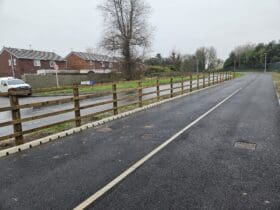A Newport Engineer has presented a new theory on how Egypt’s great pyramids were built, challenging many of the ideas accepted and shared across the world currently.
Peter James, Managing Director of Newport-based engineering company, Cintec International has written a book on his theories, ‘Saving the Pyramids’, which took 4 years to write and launched last week in an event held in Cardiff’s St David’s Hall.
Having worked on projects around the world, strengthening and restoring historically significant structures from Windsor Castle to the parliament buildings in Canada, Peter brings insight to the structural engineering of ancient Egypt.
Following the October 1992 earthquake which measured 5.8 on the Richter scale, 35 miles South of Cairo in Egypt, which had a devastating effect on buildings in Cairo, 50,000 were left homeless with 600 people killed and 6,500 injured.
Now after 24 years working on these historic structures in Cairo including mosques and maqaads, and most recently the world’s oldest pyramid, Peter’s book dispels some of the more common theories surrounding the reasons behind the deterioration as well as the original construction of these ancient monuments.
The decoding of historic construction from a builder’s perspective is examined and explained – at times against many existing theories – and the book provides a new outlook on long-held assumptions, to embrace modern theories in a bid to preserve the past.
Peter says:
“Having worked in the construction industry for 54years, I started to put myself in the mind of an ancient Egyptian builder faced with all the problems of limited tools and little experience of large scale construction.
“With the confidence of the Ministry of the Antiquities, I was asked to assist in restoring a Pharaonic Temple in the Western Desert known as Hibis. More interest was shown by the authorities in our abilities to problem solve and we were asked to restore a part of the burial chamber of the Red Pyramid.
He continues:
“I was then asked to visit the Step Pyramid to assess the damaged ceiling of the burial chamber, located 29m above the sarcophagus in an 8m by 8m vertical chamber. The ceiling was still collapsing due tothe failure of the timber beam that the ancient Egyptians used to support it. Using within the chambers our unique Waterwall airbags to temporarily support the dangerous hanging stones, our patented anchors were inserted to permanently secure the chamber ceiling.
“Whilst undertaking work in the burial chamber, diamond drilling holes over 4 meters in length, we did not encounter stones that were more than 30-40cm wide. Also, there were a lot of smaller stones bonded with Talfa (a mixture of desert grout and Gypsum). This appeared to directly contradict the common belief that the large stones on the outside were the same all the way through the pyramid.
“This observation as well as actual experience led me to question the historical theories on this and other aspects of the construction of the pyramids.”
Peter and his team will be returning to Egypt in the very near future to undertake tests in order to repair part of the Bent Pyramid. Additionally, Cintec have started repair work on Knousu Temple in Luxor through another contract from the Egyptian Department of Antiquities.
Peter’s book ‘Saving the Pyramids’ is published by University Wales Press and is available online through Amazon and Waterstones branches in the UK.







Leave a Reply
View Comments